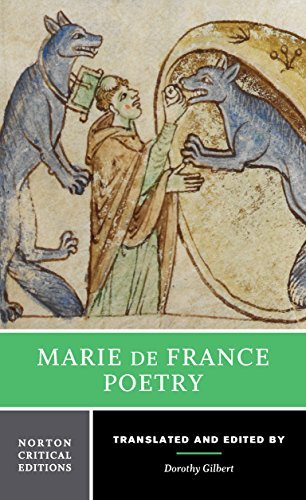What do you think?
Rate this book


Marie de France’s beautiful poems of courtly love, enchantment, and mystery are now available in a Norton Critical Edition.
Marie de France was a medieval poet who was probably born in France and who lived in England during the twelfth century. Prominent among the earliest poets writing in the French vernacular, Marie de France helped shape the style and genres of later medieval poetry. This Norton Critical Edition includes all of Marie’s lais (short narrative verse poems); selected fables; and a generous excerpt from Saint Patrick’s Purgatory, a long poem based on a well-known medieval legend. Each text is accompanied by detailed explanatory annotations. For comparative reading, two lais, “Bisclavret” and “Yönec,” are accompanied by Marie’s facing-page originals.
"Backgrounds and Contexts" is thematically organized to provide readers with a clear sense of Marie’s inspirations. Topics include “The Supernatural,” “Love and Romance,” “Medical Traditions,” “Fable Sources and Analogues: Similar Themes,” and “Purgatory and the Afterlife.” Ovid, Chaucer, Andreas Capellanus, Boccaccio, Aristotle, and Bede are among the authors included.
From the wealth of scholarly work published on Marie de France, Dorothy Gilbert has chosen excerpts from nine pieces that address issues of history and authorship as well as major themes in the lais, fables, and Saint Patrick’s Purgatory. The contributors are Thomas Warton, Abbé Gervais de la Rue, Joseph Bedier, Leo Spitzer, R. Howard Bloch, E. A. Francis, Jill Mann, and Jacques Le Goff.
A selected bibliography is also included.
432 pages, Kindle Edition
First published December 1, 2014
Whom God has given intelligence
and the great gift of eloquence
must not conceal these, or keep still,
but share and show them with good will.
When much is heard of some good thing,
then comes its first fine flowering;
when many more have praise to give,
these blossoms flourish, spread and thrive.
Along a road a wolf once fared.
A pregnant sow, as it occurred,
he met, a fellow traveler.
Speedily, he accosted her.
He said that he would let her be
if she gave birth immediately,
for he would have those piglets, now!
Sagaciously then spoke the sow:
"Sire, how can I make such haste!
So close to me I see you placed,
I cannot possibly deliver!
Shame at your nearness makes me shiver!
You don't see the significance?
Such deep disgrace all females sense
when male hands touch them, when they dare!
Sire, stay away from this affair!"
The wolf went off then, to conceal
himself; he saw he'd missed his meal.
The sow continued on, set free
by her own ingenuity.
Women all, here's one you should heed
and keep in mind for time of need:
Don't scorn, one time, to tell a lie;
Better your children live than die!